What happened at Interaction Intranet Conference 2014
The largest intranet conference in Europe kicked off with what is fast becoming a tradition of the conference – a video of Interact’s CEO Nigel Danson’s children. Their Oscar worthy performance showcases time wasting in organisations with repetition being one of the biggest culprits, begging the question “is it time for a social intranet?”.
Make it happen – adapting to a fast changing world with Professor Eddie Obeng
Professor Eddie Obeng set the tone for the day with a high octane and passionate presentation about the fast changing pace of today’s modern world.
Eddie played a video the World after Midnight to show how “Most of us spend our lives acting rationally in response to a world we recognise and understand but which no longer exists.” He then went on to explain how our systems, enterprises, education, organisations and institutions were designed yesterday and no longer fit today’s purposes.
With behaviour being a major obstacle to change, Eddie expressed the need to make people feel safe and help them overcome their fears so that they feel comfortable embracing change. Taking the fear out of change makes it easier for people to adopt but you need to provide the time to engage people and find out what those fears are and how you can help them overcome them.
You can find out more about the World after Midnight and Eddie here.
:MYWORKSPACE – changing the way we communicate and work with Jason Parkes, Mediterranean Shipping Company
Jason Parkes, General Manager of MSC gave us an insight into how they took their intranet from a static, email driven environment to the beautiful award winning :MYSPACE that delivers on the company’s goals.
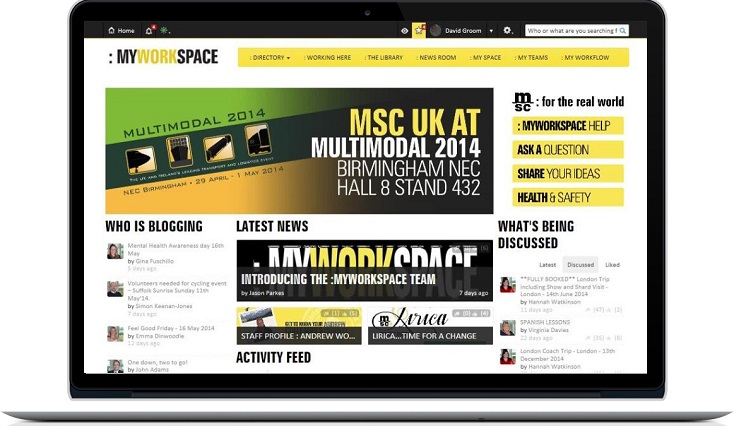
Jason talked us through their transition highlighting the steps they took along the way to ensure success:
- Direction – positioning, goals and risks
- Clear direction – where do you want to go and what might stop you?
- Governance – decisions, budget and senior sponsors
- Unambiguous governance plan
- Be clear on decision making
- Steering group represents business
- Change Management – communication, training and implementation
- Have a detailed change plan from day 1
- Try to communicate gradually rather than big bang
- People
- User focus at the heart of the project
How to make your intranet trustworthy with William Amurgis, Intranet Specialist and Director of Global Communications at NetJets
William opened his talk with some statistics about trust and they were quite enlightening:
- 79% of employees rank trust as the #1 attribute of leadership but only 20% trust business users to tell the truth
- 42% would trust their own boss but 60% would trust a complete stranger
So how do we build trust in the workplace? William gave us 10 tips to takeaway to help build trust which included:
- Respect – if you don’t trust your users they won’t trust you so make your intranet a place of trust and don’t censor the conversation.
- Accessibility – make your intranet accessible on any device, anywhere.
- Consistency – make sure you intranet experience is consistent with your company values. No two intranets should be the same!
- Consumer trends – be aware of what is happening externally as these changes raise the expectations of employees. For example accessibility via multiple devices we want information on our smartphones as well as our tablets and laptops.
- Detail – make sure your content is accurate and up-to-date to raise levels of trust.
- Stay fresh and relevant – surprise your users, keep your homepage exciting and give users something they want to see.
- Bring the outside in – don’t just keep the content on your intranet internally driven, include external feedback – good and bad, industry news etc to bring balance
- Provoke reactions – provide applications that make people want to share and welcome dissent not just agreement.
- Monitor all activity – if you’re not monitoring then you’re not listening to what your users want!
- Respond to feedback – always start with a thank you and make sure you respond to the negative comments as well as the positive comments. Don’t forget to update on the progress of feedback.
The making of a global intranet and beyond with Angela Lassiter of Linklater’s
Angela joined us to talk about her success in implementing a SharePoint intranet in an international top 10 magic circle law firm. She started by highlighting the issues Linklater’s faced which like many law firms included making the vast amount of knowledge and expertise in their business available to their employees.
She talked us through each stage of their journey identifying the obstacles faced along the way and how they overcame them. This included:
- Facing up to the problem – know this, show your Senior Management and use it to help you build your business case.
- Set clear objectives – make sure these are aligned to your business objectives and vision, and ensure you set a clear roadmap.
- Manage expectations – be clear on what you’re going to deliver and what you’re not.
- Define the scope – what do the user’s needs? Linklater’s had 720 user requirements to be refined based on what could be achieved ‘out of the box’ and how it met the pre-set objectives. Angela also stressed how invaluable the functional specification was to her.
- Designing principles – keep it simple, useful and supportable.
- Approaching the project – plan your migration including content clean up and development. It’s all about trust so content must be up-to-date or it has no integrity.
- Testing the solution – test, test and then test again. Make sure you have user testing as those who participate will become your biggest advocates if you get it right.
- Establishing governance – to ensure that the intranet continues to meet the current and future needs this includes strategy, technology, content and people.
- Engaging people – make sure people know that the new intranet is coming through gentle communication. Linklater’s also had power users which they introduced to employees along with user guides and a launch video to help encourage user adoption. The key is to get people excited and start to create the demand.
Linklaters launched their intranet on a Sunday in one go, there was no scope for a staged approach based on the business critical information that their users needed access to. Within the first 4 hours the intranet had already had over 430 users, and within the first 48 hours every user had been online and 160,000 pages of content had been viewed.
Award winning intranets made clear – a panel debate with Nigel Williams, Interact Intranet
Nigel Williams finished off the morning with a lively panel debate that gave the audience the opportunity to ask questions and participate in live polls. The panel included:
- William Amurgis, NetJets
- Angela Rossiter, Linklaters
- Kate Barnes, CrossCountry
- Kevin Cody, Small Worlders
- Paula Kenyon, Dollar Finance
Q1. How much time do you spend on your intranet each week?
Paula Kenyon of Dollar Finance kicked off the session by confirming her daily ritual which includes checking analytics, answering any questions and checking on homepage updates.
Kevin Cody of Small Worlders commented that any intranet over 500 users could potentially benefit from a full time intranet manager as Nigel Williams confirmed that the majority of the audience were not full time intranet managers but did this along with their day jobs.
Angela Rossiter of Linklaters confirmed that she was lucky in her role as a full time intranet manager as it has allowed her to build trust in her organisation as it is her responsibility for driving the intranet forward and continue to meet user needs.
See the first poll results below:
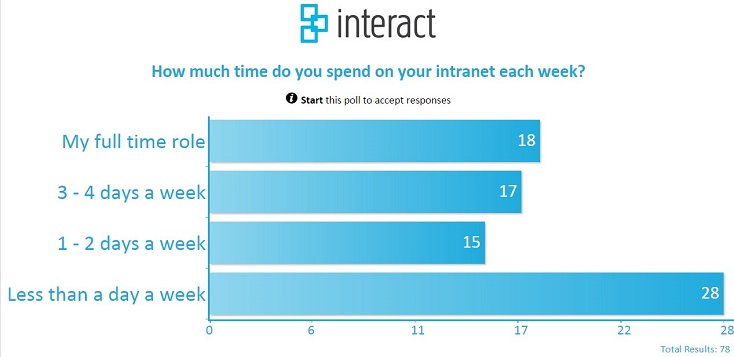
Q2. Which 3 things are you most proud of?
William Amurgis commented that he is really proud when people who work for him get promoted, seeing executives move from email to intranet and when you can demonstrate business value from what you are doing.
Kate Barnes confirmed her proudest moments as being when users go on the intranet and make their voices heard via suggestions and when their Senior Executives get involved with their intranet by answering questions, writing blogs etc.
Paula Kenyon said that she is really proud of being able to trust their staff to blog, post comments etc making their intranet an open and free environment.
Q3. Which parts of your intranet would you most like to improve?
Kevin Cody commented that search is always an area that people want to keep improving, to make it easier and faster for relevant content to be found.
William Amurgis would like everyone to have a complete profile so that they can connect with each other and start to take ownership of the intranet.
Angela Rossiter went on to comment that an intranet is a significant investment which should be nurtured and evolved like any other major business investment.
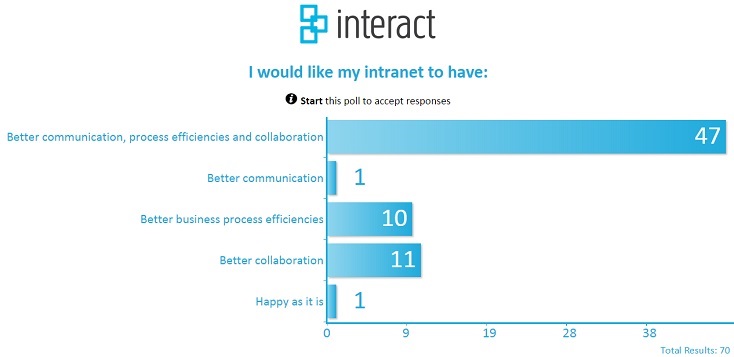
Q4. How many champions or helpers do you have?
Angela Rossiter as a global intranet manager has a team of 12 intranet champions that play a crucial role as ambassadors. These on the ground helpers are located around the globe ensuring that users have someone to go to if they require help or guidance on anything intranet related. They also provide invaluable feedback on what is working and more importantly what isn’t.
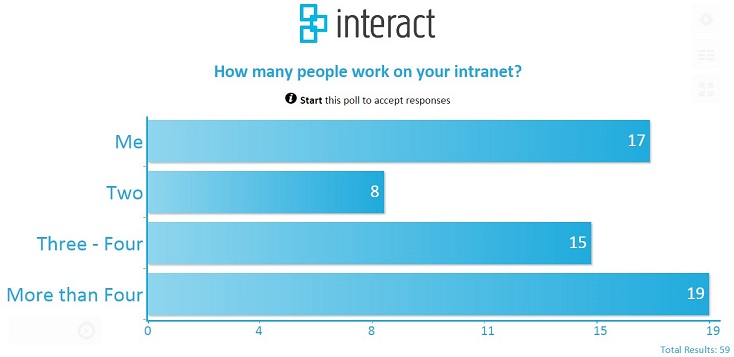
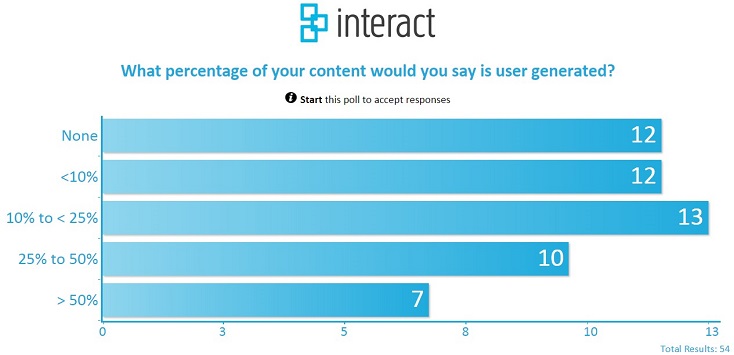
Q5. What have you gained from entering awards?
William Amurgis talked about how awards are a game changer – you’re publicised, you get invited to speak at great events and visit places you’ve never been before and all employees share in the glory as they work for an award winning company.
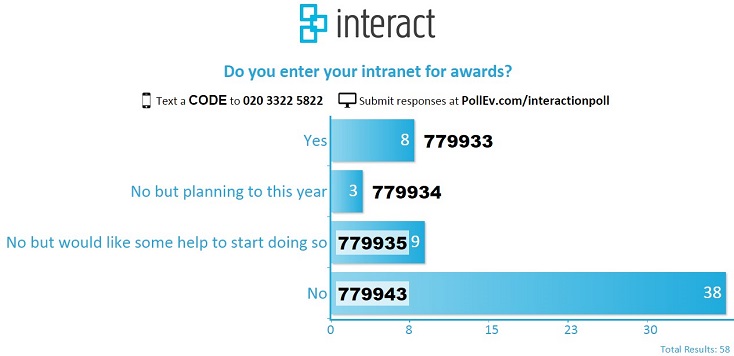
As the first part of the conference concluded with a fantastic lunch and some time spent in the Expo area looking around the intranets on tour and speaking to those responsible for managing them, our delegates were then able to tailor the afternoon sessions to meet their own requirements.
So much to learn so little time!
With three streams to choose from delegates where spoilt for choice. Each stream had four mini sessions which included some theory, practical examples and case study based content, and time for users to move around the streams attend the sessions that were of most interest to them.
Engaging CrossCountry with Malcolm Cotterell
Malcolm Cotterell, CrossCountry’s Employee Development & Engagement Manager, delivered a great insight in how they have driven engagement within their intranet. He highlighted several key points about how they have used their intranet – Connect, as an extension of their brand ensuring it reflects the values of the business.
Key highlights included:
- Part of their mission was to make being in work feel as ‘sunny’ as possible by making things easy where they could.
- Using the intranet to visibly empower leadership amongst their users.
- Give their users a voice – make the users the main focus of the intranet and encourage them to participate.
- The importance of maintaining organisational integrity to gain user trust
Malcolm ended his session with the poignant YouTube video Look Up that left the audience in contemplative thought.
Launch a beautiful and engaging intranet in just 11 weeks with Lawrence Spence & Ryan Kaye of DWF
Lawrence and Ryan from DWF took us on their journey showing how you can, although they didn’t advise it, build and launch something that not only delivers on business objectives but also looks good too, in a short timescale.
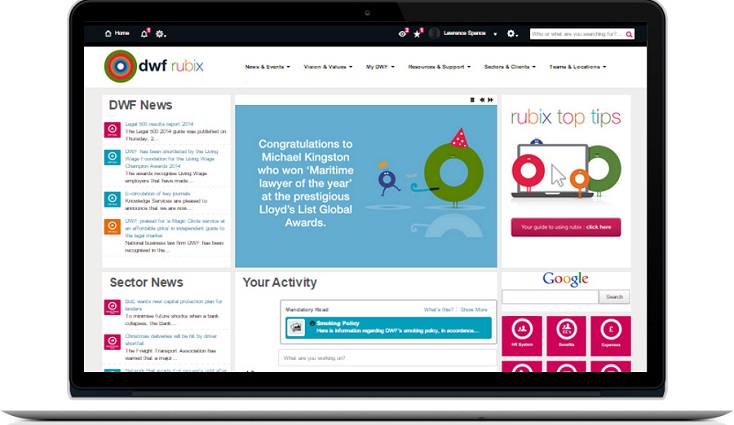
Their enthusiastic and no nonsense approach to what has been a fantastic project in Rubix – their intranet and what a pretty intranet it is too winning joint best brand with Staffordshire Housing at our annual Intranet Excellence awards the evening before.
The key points from this presentation included:
- Primary objective of the project was to ‘engage everyone’!
- Needed to reflect the new internal brand – the ‘O’ men
- Used focus groups and surveys to research user requirements
- Rubix was named via a competition which included over 400 suggestions and the winning name getting over 350 votes
- Launch included a video that also tied into the new internal brand and vision
- Feedback has been mostly positive since launch
Journey to the promised land – internal social media at Deutsche Bank with Paul Hewitt
You don’t really consider social media in an industry such as banking so I was really interested to find out how this would work in this type of environment.
Paul explained that they wanted to adopt social media as a way to make work life more fulfilling for the employees with the promised land being to “work in an open and connected way” opening up the doors for connected working and collaboration across Deutsche Bank.
Their journey to success has included a 6 stage journey which has taken the last 9 years to get to their current position. The stages include:
- Experimentation
- Conceptualisation
- Launch
- Pilot
- Revolution
- Professionalisation
Paul highlighted some of the objections that they had to overcome along the way which included their ability to meet the strict legal and privacy laws the sector is governed by. Paul confirmed the successes of the project being able to identify four bank wide programmes derived from myDB.
Building an intranet brand is a piece of cake with Sandra Barber and Mark Brookes of Staffordshire Housing Group
Stream 1 finished with a fantastic presentation about Cake – Staffordshire Housing Groups award winning intranet – it was a joint winner with DWF for Best Brand in our awards evening the night before.
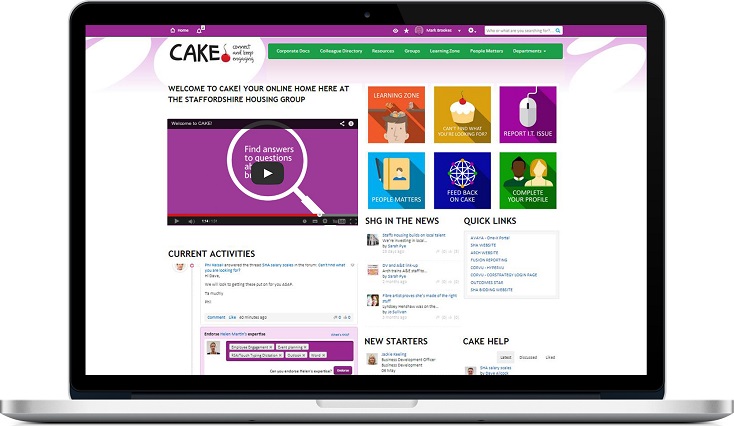
Sandra and Mark walked us through the thought process they went through to achieve an intranet brand that reflects their internal values and drives engagement throughout the group.
Staffordshire Housing Group have come together from a number of different Housing Associations with a distinct us and them culture, so this project was a way of making everyone feel inclusive and part of one company.
Sandra and Mark talked us through their 4 step process to achieving intranet brand success:
Step 1: get the name right – Staffordshire Housing had a naming competition which helps to get the message out that the intranet is coming and starts to engage people at a very early stage.
Step 2: get the right logo – they wanted something that reflected their working culture which was seen as fun, collaborative, creative and efficient.
Step 3: get the right look and feel for the site – they wanted something that users could identify as unmistakably Staffordshire Housing Group.
Step 4: keep it seamless by branding your launch too – on launch day employees came in to a full launch pack which included a branded placemat that gave full instructions for how to use Cake, a set of cake branded headphones and a massive muffin.
It seems that Cake resonated most with the attendees of Interaction as they also won the best Homepage competition which had over 30 entries at Interaction. Take a look at all of the entries in this competition. Click Here.
Connecting employees via digital communication with Dennis Agusi of Philips/ Netherlands
Denis used his session to show how Philips have successfully integrated a digital social platform to connect employees to each other and the values of the company and help to make Philips a more human organisation.
Philips wanted to create empowered digital employees that could:
- Make better informed decisions using collaboration tools
- Be more efficient and productive by being able to access relevant personalised content
- Deliver results faster by being able to connect to the right people and the right information to do their job
How did they do this?
- Set up their social enterprise network to be the Google of Philips
- Used gamification to drive engagement
- Used video as a way for users to engage, creating their own ‘bluetube’ so that users could blog using video
6 changes needed to overcome collaboration skepticism with Nigel Danson, Interact CEO
In this session, Interact CEO Nigel Danson discussed the changes businesses need to adopt if they are going to reap the benefits of collaboration.
The 6 changes are:
- Business leaders need to adopt a new mindset
- They need to embrace the business benefits of collaboration in order to see them successfully adopted throughout their organisation
- The need to understand what is and isn’t time wasting. They can’t expect employees to work collaboratively and share knowledge if they are then going to dismiss blogs and forums as a waste of time.
- Companies will embrace the demand for working anytime, anywhere
- Businesses will need to address the increase demand for bring your own device (BYOD) as the lines between work time and non-work time blurs
- They will need to support an IT environment that mirrors the more social, mobile and participatory experience people have outside of work, to increase employee engagement and enhance their ability to make positive contributions anytime they want.
- People will value face to face meetings more
- While the increase in online collaboration is inevitable, face-to-face meetings will still take place with a blend of both for effective collaboration.
- People will be more selective about what justifies the additional time required to travel to and/or attend face-to-face meetings to ensure they are not classed as a waste of time.
- New employees will be part of your business before their first day
- An online platform with collaborative tools will become critical in the on-boarding new employees giving them access to the information they need to get up to speed with their new role and company.
- Giving advance access to your intranet before a new employee starts gives them the opportunity to start to develop relationships with colleagues, understand the business and become part of the community so when they start they are ready to hit the ground running.
- Collaboration tools will just become tools for work
- Having a good platform won’t be the only requirement for good collaboration, businesses will need to provide information on why and the benefits of these tools for their role.
- Changing behaviour is key to the adoption and success to new ways of working, the users must be at the heart of everything and the individual benefits clearly communicated.
- The impact of collaborative technologies will be measured
- In order to recognise the importance of collaborative working it must be measured and communicated
- The use of analytics will be critical in driving improvements in the way people work together collaboratively.
Nigel used examples to show how some of Interact’s customers have succeeded in driving collaboration through their business. These included Dollar Finance Group, Silver Chef and ASPCA. Read Nigel’s blog on the 6 changes needed to overcome collaboration scepticism.
Knowledge sharing and collaboration. One is better than the other. Or is it? With Erica Hurley of University of Warwick
In this open discussion Erica talked about her work with the Knowledge Innovation Network (KIN) understanding knowledge sharing and collaboration from a theoretical point of view and how this applies in a business context.
Erica discussed the 3 generations of knowledge sharing this included:
- First Generation: Explicit Knowledge which includes artefacts, libraries and other knowledge assets.
- Second Generation: Tacit Knowledge which takes place through the exchanging of information with our peers and communities.
- Third Generation: Emergent Knowledge which is developing through networks and innovation.
Erica used the wikid model to show how we to transform information from the basic level which is classed as data to the top level of knowledge which is wisdom and power, and the human component needed to complete the transformation which increases at every stage. Alongside this increase in the human component she also showed how as the human interaction with data on its journey increased so did it’s perceived value to the organisation.
She concluded that although we have always shared knowledge it becomes apparent that we only share what we want when we want or when we are told to whereas with collaboration it is seen as a place that reciprocal knowledge sharing can take place and the benefits are felt by everyone.
Rethink your intranet, a vision for a networked future with Janus Boye of J.Boye
In this engaging talk and the last from stream 2, Janus discussed how we look at our intranets and how ownership is needed in order for businesses to benefit from the tremendous potential they offer. He highlighted how businesses become too focussed on the platform rather than on the user and how it will help them to do their job better and highlighted this as a major issue in the success of an intranet project.
Businesses need to change if they want to benefit from an intranet, any business can install a new platform but that doesn’t guarantee success if the users don’t feel part of it or see the benefit to them.
So how do we rethink our intranet? Janus recommends piloting projects external to your organisation as part of the learning process. Don’t jump in to the trap of procuring new technology because you’ve uncovered a problem. Think about how you can use key individuals and groups such as your customers, partners, citizens, patients, parents, and pick one among your key target audience and then bring them inside your sacred digital halls.
Janus suggests that we open up to new levels of innovation to unlock lasting business value that will make your intranet unrecognisable compared to today and no longer define your intranet by who is working for the business.
Stream 3
Ideation – using your intranet to collaborate, innovate and improve performance with Ben Birchall of Progression Communication
Ben kicked off the first of stream one’s session with some group interaction asking the audience to pick 3 words that represent ideation to them of which there were lots of different examples. He used this to show how when we come together as a group we bring together our diverse ideas which has great potential for any organisation.
Some key points Ben highlighted included:
- No innovation starts without an idea – but where do ideas come from? An intranet is a place to facilitate thoughts and ideas.
- Why ideation – understand why you are doing it, improve performance and good practice.
- What are we looking to collaborate on or create ideas around? Focus on performance improvement, listen to your stakeholders NOW not from a survey you did 9 months ago.
- Involve as many stakeholders as possible
- Ideation works best when it occurs frequently and regularly – every month release a new theme or suggestion and put short time frames around it.
Ben closed by highlighting the importance of feedback and making sure it is inclusive so you listen to what others have to say. Closing the feedback loop is important otherwise future feedback won’t generate much success. You need to acknowledge failure and encourage future ideas.
To find out more on Ideation, Progression Communication are running a workshop in November, you can sign up here.
Intranet content tactics – executing your strategy on the page with Wedge Black of Kilobox Communique
This session with Wedge took us beyond the technical side of intranets to look at its purposes:
- Community
- Collaboration & Cooperation
- Business processes
- Communication
- Culture
- Direction & Vision
In order to deliver on the purposes you need to have content and in order to have useful and usable content you need to have a strategy but not one that is so big contributors ignore it!
Content tactics include:
- Micro content strategy
- Page level/ interaction level content strategy
- UX + UI + ID + communications
- A matter of scale and focus
Wedge provided some clear advice to take away:
- Headlines – make them effective they are what people use to identify what they are going to read and what they are not.
- Images – think about how they attract interest and add meaning to your content, and make sure they look consistent. Use internal images and avoid clip-art.
- Links – embed into meaningful text within your sentences and let people know if you’re linking to a file.
- We don’t read we scan – make it easy use subtitles, summaries and imagery to help.
- Don’t write for your boss write for your audience – express your excitement.
Accepting the unfinished: your ever-evolving intranet with Martyn Perks of Thinking Apart
Martyn opened his session by expressing the importance of not trying to be too perfect – the goal should not be to perfect tools, business cases etc but to do things in a faster manner to try and keep up with ever changing world around us. He also expressed that failure is ok – try and then if it doesn’t work move on.
Martyn said that we need to recognise that things change we can’t adopt a fixed position and expect for it to continue to serve its purpose when business goals are constantly changing. This is apparent with intranets as we can get so transfixed on trying to make everything perfect – remember intranets are really just platforms: infrastructure to free up content.
Martyn had some great tips on how to keep your intranet evolving:
- Build straight out of the box – to avoid getting caught in the expensive luxury that is bespoke
- Switch between standard and components – use bolt-on’s and modules to find out what works
- Create governance that encourages – adopt an open approach so you can try tools to see what works and what doesn’t. Don’t be afraid of failure.
- When you stop focussing on the importance of the technology you concentrate on the business problem.
Martyn’s session concluded with an open debate with the audience about the importance of tools in relation to the platform and how you manage this.
10 steps to ensuring your intranet journey is successful with Kelly Freeman and Steve Osborne of Interact
Kelly & Steve, Interact Intranet’s very own strategist closed stream 3 with a run down of the top 10 steps to a successful intranet journey which was entertaining and informative.
What are the top 10?
- Tell me what you want – if you can’t establish this then how can you move forward?
- Make friends with your stakeholders – find out what they want, your bosses need to know what the users are saying.
- Find the right provider – look at all your options, don’t just consider the tools look at what you really want and identify what provider is the best fit.
- Beautiful – not just superficially, everyone wants something pretty to look at but you also want to create engaging and informative communications too.
- Do it – allow time, make sure you can meet the deadlines set by others, if not map it out and make them understand what is achievable within the confines of your role and that of your teams.
- If you need to re-plan then re-plan – stress is un-avoidable when launching an intranet, if you need to revisit your plans for whatever reason then do it.
- Don’t forget the launch plan – make this a pivotal part of your whole project plan and make sure it answers that key user question ‘what’s in it for me?’
- Trust – collaborative work doesn’t just happen, it will take time and also encouragement particularly from other users. We tend to view things as less scary if others are doing it particularly leaders.
- Measure the success – don’t just rely on analytics, ask the users, use your forums for feedback on what’s working and what’s not and share this with stakeholders and use it to shape your roadmap.
- Keep things going – the work doesn’t stop after launch! You need to keep your intranet evolving – try new things, failure allows innovation so don’t be afraid to try something and if it doesn’t work move on.
They left us with one bonus feature – criticism, everyone’s an expert when giving it but don’t take it personally it’s an opportunity to gain feedback and turn negatives into positives.
The conference came to a fantastic end with a drinks reception and the presentation of a cheque to Barnardo’s the official charity sponsor of Interaction 2014, for GBP1150.
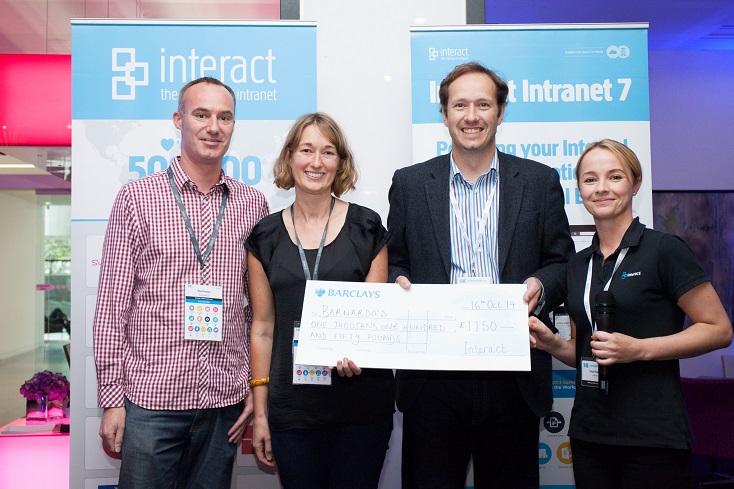
Chris Moss of BPHA was the lucky winner of our mini ipad competition.
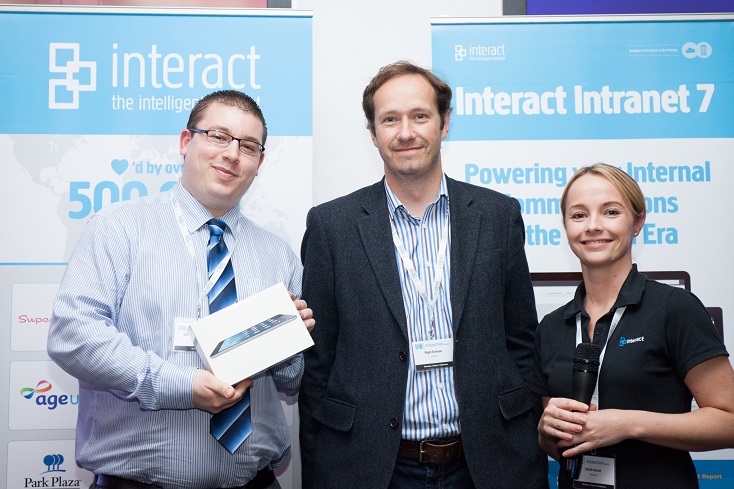
And our wonderful homepage wall had a winner declared with the conference delegates voting for Staffordshire Housing Group’s Cake as the best!
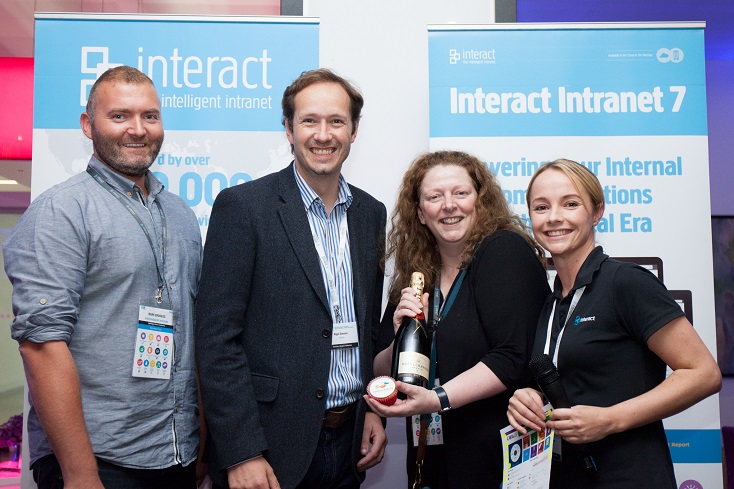
So that’s it for another year. Interaction Intranet Conference will be back again in 2015 so make sure you don’t miss out.
